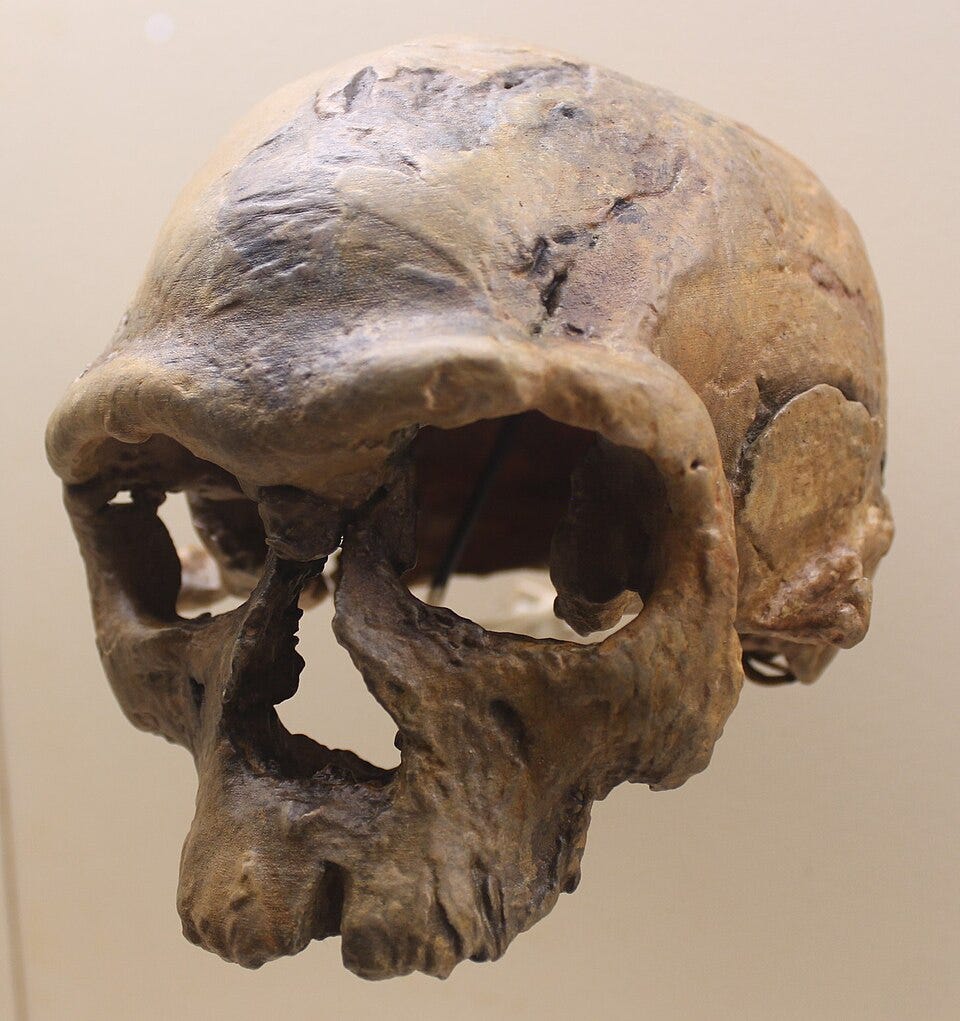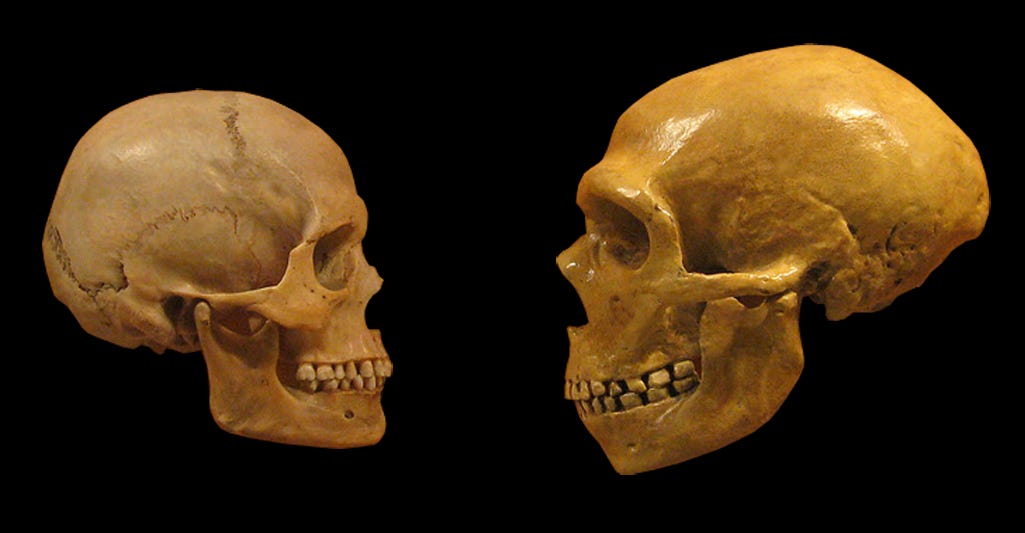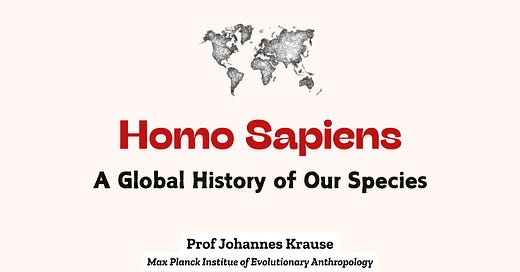This is where our story truly begins. In Episode 4 of The Origins of Humankind, we finally turn the spotlight on Homo sapiens.
Guiding us through this journey is Johannes Krause, director of the Max Planck Institute for Evolutionary Anthropology and a pioneer of one of the greatest scientific revolutions of our time: the science of ancient DNA. This ability to extract genetic material from fossils has transformed our understanding of the deep human past, not just of kings and conquerors, but of ordinary people, long gone.
You can listen to the full episode below. Alternatively, you can keep reading for some highlights. For a deep dive, see Krause’s excellent book, Hubris: The Rise and Fall of Humanity.
Listen (1h10): Spotify | Apple Podcasts | Other players
This is part of the Origins of Humankind series produced with CARTA (UC San Diego). You can enjoy each episode as a stand-alone, or head here for the whole experience.
The Rise of Sapiens
We are all Made in Africa — doubly so. It is in Africa that the first hominins evolved. Some of them left. Others stayed. And from those that remained, a new form of human evolved. This was our form, the hubristically named Wise Man, or Homo sapiens.
The earliest remains of Homo sapiens are from Morocco, dating back approximately 300,000 years. Africa remained our sole homeland for millennia. But things changed.

Around 50,000 years ago, Homo sapiens burst into the global scene. It was a world-changing wave, even if it was not the first of its kind.
Small groups of Homo sapiens had ventured out of Africa before. We find Sapiens remains in Greece from approximately 200,000 years ago and from the Levant 100,000 years later. And these were Homo sapiens all right. But they were not our ancestors. These populations were genetic dead ends — branches of our family tree that were cut short.1
But third time lucky.
Around 50,000 years ago, a new wave of Homo sapiens ventured out of Africa. In less than ten millennia, their descendants had reached India, China, Siberia, and Europe.2 As they spread, they encountered other humans, including the Neanderthals and Denisovans. They mixed and mated with them — with both males and females. But they didn’t stop at their territories. They pushed further into the unknown. In the south, they discovered Australia. In Asia, they climbed into the Himalayas. In the north, they pushed far into the lands of ice, further than even Neanderthals. As Krause said to me:
“It's quite surprising for an African hominin, that after leaving Africa, the ‘first’ thing they do is go to the Arctic.”
How did they do this?

They didn’t have bigger brains than Neanderthals. Nor were their bodies as well adapted to the cold. As a striking example, these Europeans still had dark skin from their African ancestry — a feature which only disappeared from Europe with the arrival of farming-related vitamin D deficiencies.
So what was the recipe for our success?
“I think it's just technology that allowed it. We probably had more cultural abilities, better technologies, and that probably allowed us to expand into environments that no hominins were before: the Arctics and high mountains; crossing the seas; discovering new continents like America or Australia.”
This doesn’t mean that Neanderthals were the mindless brutes their name implies in pop culture. Like Chris Stringer told me, “that gulf between us and the Neanderthals” has been diminishing in the last 20 years. Perhaps so. But it hasn’t disappeared, Stringer added. Krause agreed.
Take the treatment of the dead. Neanderthals, too, sometimes buried their dead. However, they also ate them not infrequently. Indeed, Krause told me that cannibalism is a relatively typical finding from Neanderthal sites. We don’t know whether this was a ritualistic or purely survival-based practice. But it does contrast with Sapiens remains, where cannibalism is less frequent.
When buried, Neanderthals did not receive the same treatment either.
“There are no grave goods. That's something that's very different. When you have modern humans coming to Europe, you have some really beautiful burial with thousands of beads and figurines. Hours and hours went into producing them and they gave them to [the dead].”3
Sapiens humans also brought musical instruments and created elaborate cave paintings.

This might reflect a more “symbolic thinking style” as Ian Tattersall told me, or a more complex social organisation with bigger networks, as Chris Stringer suggested. But whatever the explanation, all evidence hints at some social peculiarity in the lifeways of our ancestors.
And this speciality reaped rewards.
Around 16,000 years ago, a group of humans ventured deep into the far east of Siberia, crossing the Bering Strait and discovering the vast lands of the Americas.4 With tremendous speed, they settled the whole supercontinent.
Except for Polynesia and the farthest edges of the Arctic, humans were now living on all habitable corners of the world. Indeed, only 35 millennia after their final explosion beyond Africa, humanity's spread had reached the edges of the world. And the Earth had been transformed. Gone were the Neanderthals, Denisovans, Hobbits, and the Dragon men. Mammoths and giant sloths followed suit, vanishing from the Earth in our wake.
Why?
Krause was confident that Homo sapiens caused much of the extinction of the megafauna.
“When humans came to Australia, all the megafauna was done within like 2000 years. When humans came to New Zealand all the big birds are soon gone. Same happened in Eurasia. Same happened in America. So we are such efficient hunters that we kill almost everything that is different and that we can eat.”
Krause was less convinced that we killed the Neanderthals.
“We might have killed some of them,” he said agnostically. But the traditional picture of a battle between Sapiens and Neanderthals has been overturned by ancient DNA evidence.
In the traditional model, Sapiens arrive in Europe, live alongside Neanderthals, and prevail as the winners. Even here, the story leaves much room for non-violent explanations. But this story is wrong. The DNA evidence shows that the first migrations to Europe were genetic dead ends. These populations perished, too — perhaps with the Neanderthals.
“Around 39,000 years ago there's a volcano in Italy that erupts. It's a massive super volcano and it leaves an ash layer all over eastern Europe, deep into Russia. And that really coincides perfectly with the extinction of Neanderthals and with the disappearance of early [Homo sapiens] groups that were there.
Europe had to be repopulated. Luckily for us, Homo sapiens had already become a global species. In little time, newcomers filled Europe again.

If correct, this new picture no longer supports the notion of a European contest between two species of humans. Rather, we see a contest between one European (or western Eurasian) species — Neanderthals — and one global species — Homo sapiens. The deck was loaded from the start. It was loaded in our favour. And it was loaded because of our peculiar cultural knack for moving further and further than any other human the Earth had seen.
And thus, we had taken over the world.
But this was not the end of the story. This was the beginning of the greatest transformation in the story of humankind. It was the dawn of everything we call history and all things that resemble modernity.
It is the topic we will turn to next week, in the final episode of The Origins of Humankind.
Thanks for reading these highlights! We discussed many more topics in the episode, from war and peace in the Palaeolithic to the problem of thinking about “races” in genetics. You can listen to the episode on Spotify, Apple Podcasts, or wherever you get your shows. For earlier episodes on The Origins of Humankind, head here. You can get Krause’s book here.
Enjoy!
We know these were dead ends because all modern ancestry points to either Africa or a single “Out of Africa” event less than 50,000 years ago. This can be detected from the small amount of Neanderthal DNA in all non-African lineages, which was acquired through interbreeding with Neanderthals less than 50,000 years ago.
Erratum: In the original version, the beauty of alliteration had lured me into writing “Scandinavia”. I quickly realised that this is false. Scandinavia was uninhabitable for most of the Ice Ages.
Krause acknowledged some suggestions of Neanderthal grave goods, but explained that these are contested and rare in number.
Krause was open to human habitation in the Americas before 16,000 years ago. This is an ongoing debate. However, he was firm that any occupation before this wave was a genetic dead end. There might have been humans in America, but they didn’t pass their ancestry to the indigenous populations of today.





